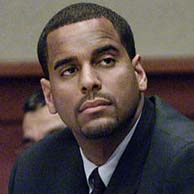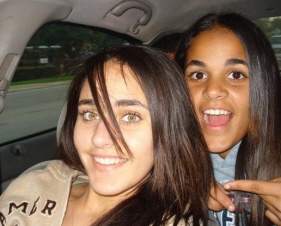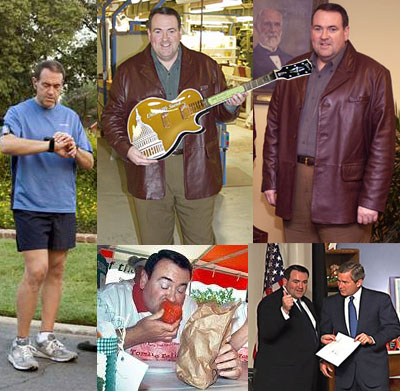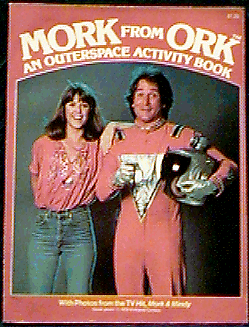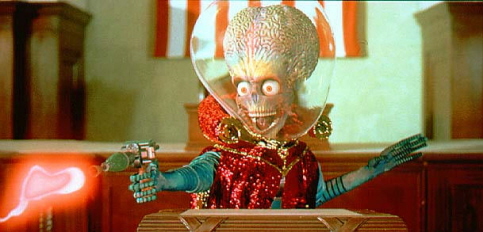By Debbie Schlussel
**** COMING SOON: DebbieSchlussel.com Best/Worst Movies of 2007. Stay Tuned. ****
Just over a week ago on Friday, I reviewed most of the new movies out for the holiday weekend, as well as most of those that debuted on Christmas. But there were a few I did not get to, others that weren’t screened for critics, and a few that only came out in limited release in New York and L.A. Several are extremely depressing movies. Here are my reviews of the rest of the rest for 2007:
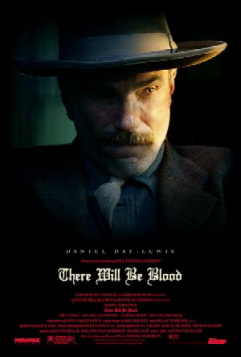
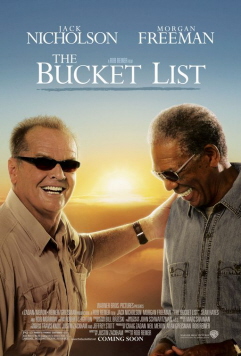
* “
The Bucket List“: This movie debuted in New York and L.A. on Christmas and will get to the rest of the country by Friday. Part comedy, part drama bout two men who are dying of cancer, it was hard for me to watch because my late father recently died of cancer. The ending is especially sad. That said, Nicholson delivers a typical Jack Nicholson performance–good as always, even though his character is a lout with very little redeeming about him (kinda like every Nicholson character). He and Morgan Freeman are the cancer-stricken men.
Nicholson is a greedy, womanizing, rude and condescending billionaire hospital tycoon. Freeman is a mechanic who wanted to become a lawyer and instead settled for the greasy undercarriages of cars to put his wife and kids through a good life. By chance, they are in the same hospital room after learning of their diagnoses. Nicholson wants his own room, but his policy is “two to a room, no exceptions,” and his assistant reminds him that a solo room for him would be bad PR.
Together, the two men spend their final days making–and living out–The Bucket List, the “things you want to do before you kick the bucket.” They do the expected–skydiving, visiting the Pyramids in Egypt and the Taj Mahal in India, as well as other wonders of the world and sights and scenes–as well as the unexpected. It is at times both funny and touching, at other times predictable, and at other times downright annoying. Having an affair and cheating on his wife to whom he’s been loyal for forty years was not on Freeman’s list, yet Nicholson tries to tempt him, since he (Nicholson), himself, has never been faithful or able to hold on to any of his multiple wives.
Clearly, there’s no reason for the audience to care about the creep Nicholson plays, but is there ever (most of his characters are villains or otherwise morally bereft)? The Morgan Freeman character is, on the contrary, very admirable (as is the character he plays in most of his movies). In the end, though, Nicholson gives Freeman the best last few months he’d ever have gotten, though they selfishly take him away from his loving family.
* “
There Will Be Blood“: After watching this movie, my bottom line was this: I much prefer Jed Clampett. He, granny, Jethro, and Ellie Mae may have been the target of mockery for their downhome, middle-American hillbilly ways. But I’d much prefer them as neighbors to the main character in this movie, also a beneficiary of black gold/Texas tea, etc.
Based lightly on Upton Sinclair’s novel “Oil!”, this movie features everything Hollywood loves and loves to hate: hypocritical, phony Evangelical Christians (I don’t think they’re hypocritical and phony, but this movie does), naive, gullible, unsophisticated townfolk all over middle America, and big, bad, evil businessmen. And that’s why movie critics nationwide are picking this long, boring flick as
their best movie of the year. It’s also why it will be a major Oscar contender.
This debuted in a few select theaters before the end of year (for Oscar contention purposes), and will spread to the rest of the country in the next couple of weeks.
Starring
Palestinian terrorism apologist Daniel Day-Lewis, this movie is almost three hours long. While it is beautifully shot and began as a very interesting period piece on the oil boom in America at the beginning of the 20th century, “There Will be Blood” degraded into an anti-Christian and anti-business rant, which never let up, even until the final scene. And this ideological slant–especially the anti-Christian propaganda–isn’t subtle. It’s sledgehammer material.
This movie makes clear, through it’s elitist lens, that it sees middle Americans–especially Christian ones, as a simplistic and naive lot. The moviemakers’ snobby disdain for that part of America–not just a century ago, but now, too–is made more than clear.
It’s about an oil prospector-cum-multi-millionaire oil magnate, Daniel Plainview. He gets whole towns to invest in his company after some of his oil-well drilling is a success. Soon he gets a tip from the son of a poor rancher in a dusty Western town that there is oil underneath. Using shrewd (and sleazy) tactics, Plainview convinces most of the townfolk to sell to him, with the promise that he will take care of the town, build schools, etc.
But his biggest obstacle is the down home middle American values of this town, especially the Christan faith. Most of the town belongs to an Evangelical Church led by Paul Sunday, whom Plainview disdains. But eventually, Plainview–who is basically an atheist–must join Plainview’s church and pretend to buy into the theology to get what he wants.
Plainview is a bitter, curmudgeonly man, who only grows more so, throughout the movie. He is cold-blooded, a killer, and not someone with any sort of moral compass. He is very willing to sacrifice the lives of others, including that of those close to him for his oil and his millions.
Woven throughout the story are the Christian Minister Sunday, who is shown over and over again to be a charlatan, willing to sell out his beliefs and his Church for riches, and Plainview’s cute young son. Initially, the son is a marketing ploy for Plainview, but eventually he is abandoned by his father after he goes deaf in an oil well accident.
Although the movie starts out well, as fast as it sucks you in, it sinks into misery. And you wonder where the three hours of your life went. Well, it went to suffering through a rant against Christians and business. Not a worthy pursuit. Though this movie has great cinematography and a magnificent presentation of scenery and costumes from the West at the turn of the last century, that’s not enough to redeem it.
Skip it.
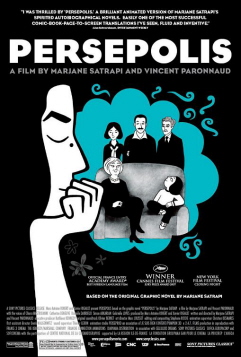
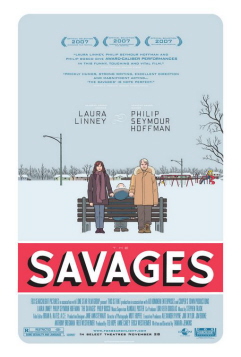
* “
Persepolis“: When I screened this with other Detroit-area movie critics, most of them didn’t get it and were quite ignorant. One said to me, “See, Debbie, not all Arabs are bad.” But, in fact, this movie is not about “Arabs.” It’s about Iran, where they are non-Arab Muslims. And it’s definitely about Islam, and what happens when believers in this religion take over. It’s also about what happens to secular Muslims when that happens–they are crushed like bugs and their human rights are taken away.
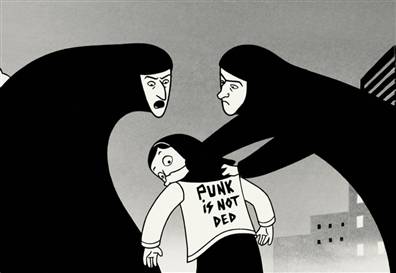 “Religion of Peace”: No, These Are Not Nuns
“Religion of Peace”: No, These Are Not Nuns
Another critic, Jeff Meyers of “The Metro Times,” suggested that the Detroit Film Institute, part of the Detroit Institute of Art–which is, sadly and ironically, showing this movie along with the “Man From Plains” fake-umentary glorifying Jimmy Carter–have a joint showing with the National Arab American Museum of Dearbornistan. But that museum features hijab and burqa fashion sohws and stands for the promotion of Islamicization of the world, where as this movie, “Persepolis,” shows the deadly results of that movement. Myers–quite ignorant of the ongoing activities of the falsely-named museum, which stands for Islam and not Arabs–took great offense when I doubted his suggestion. He clearly hasn’t visited the building.
“Persepolis” should be viewed by all Americans–make that, all Westerners–who believe that faux “reformers” can do anything to change the Islamo-fascist world. Where now, the Bush Administration has engineered the near overthrow of a pro-Western dictator of Pakistan and incited (with its insistence that Musharraf allow the late Benazir Bhutto back into the country) the worst violent and instability in Pakistan in decades, our country did the same when Jimmy Carter ushered the Shah of Iran out of office in favor of “free,” “democratic” elections, which brought almost three decades and counting of crushing Islamist rule.
Animated and in black and white, this movie by graphic novelist Marjane Satrapi–an Iranian refugee living in France–illustrates what happened after intellectuals and revolutionaries, including her own parents, overthrew the Shah. At first, they thought they’d bought their golden ticket to freedom, democracy, and paradise. But they soon realized that life under the Shah–which they so actively protested and succeeded in ending–was far more desirable than what their “revolution” wrought.
Not for kids, the movie shows how Iranians lived then (and now) in eternal fear and persecution. Kidnappings, tortures, murders–all sponsored by the Islamist Khomeini government–became a way of life in response to the most benign of comments and actions by average Iranian citizens. We are told how Iranian kids were forced to run through minefields, to explode the remaining mines. We’re also told how–because it is against Islam to kill a virgin–guards in Iranian prisons married and raped girls, so they could then be executed.
The movie is autobiographical, as we watch Marji (the young Marjane Satrapi) grow up in the stiltifying aftermath of the Islamic revolution in Iran. Though Islam is never mentioned by name, it’s quite clear who is the cause of this extremism. Women in hijabs and religious police take over every institution and school. Marji is almost beaten for wearing “radical” Chuck Taylor basketball shoes and a “Punk is Not Ded [sic]” T-shirt, along with her Muslim headcovering. The headcovering is the symbol of the oppression that has set in, the rights that have been taken away, the persecution that becomes a way of life.
We see how Islamism and religious intolerance invades–and ruins–nearly every aspect of Marji’s life and that of her family. Eventually she escapes to Europe, never to return, but being forced to leave her family in that hellhole. (In French with English subtitles.)
* “
The Savages“: Although this is kind of a sad, depressing movie, it is made good by the humor and great acting of Philip Seymour Hoffman. He plays a college professor in Buffalo, and Laura Linney is his sister a failed playwright in New York. Both are miserable and do not get along. But they must come together to care for their estranged father, when they learn he is stricken with Alzheimer’s disease and dying. Hoffman’s one-liners at the expense of his whiny sister make this movie. Not a happy movie or one you see to escape the drudgeries of life. This one reminds you of them.
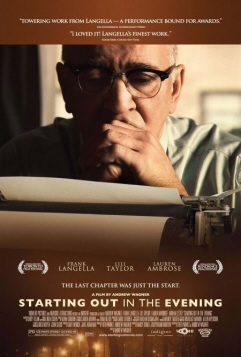
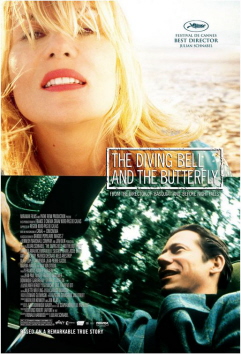
* “
Starting Out in the Evening“: This is another of the string of depressing, sad movies that are hitting arthouse theaters to critical acclaim. People go to movies to escape and feel better. If they must be saddened, there should be a point to it. And there doesn’t seem to be for any of these sad ones (“The Savages,” this one, and “Diving Bell and Butterfly” (below)).
Frank Langella plays an old novelist, who at 74, has spent a decade trying to finish his final novel before life finishes him. 50 years earlier, he was a successful novelist, but now his books are out of print, and, in an equally depressing side story, he sees his unambitious, directionless daughter, at age 40, unmarried, and racing her biological to have a child, even though she is with a man who does not want marriage or children and has treated her badly. Langella sees these as dual failures in his life.
But a pretty, full-of-life, young, 24-year-old student suddenly comes into his life, wanting to do her grad school thesis on him. She promises that this will bring his long-out-of-print books back in print and renew interest in his work. At first, he declines. But eventually, he succumbs to the excitement that the interest of a woman a half-century younger brings into his life.
I found this movie very uncomfortable, as did Langella’s character. You can feel his discomfort as the 24-year-old tries to seduce him by spreading honey over his face. It’s too silly. The age gap is too big. And soon, it brings calamities on his life, showing us that his initial declinations of her interest were the right instints, wrongly disobeyed.
A great example of what left-wing thought and behavior does to a family. No, that’s not my insertion of politics. Characters in the movie write for the Village Voice and explicitly speak of puttig together “left-wing” magazines of thought. All of the characters in this movie are from New York’s Upper East Side left-wing intellectual crowd/intelligentsia. Maybe that’s why they and their lives are so depressing.
* “
The Diving Bell and The Butterfly“: This is the third in the trio of depressing arthouse films just released. The young, male editor of French Vogue is stricken by “locked in syndrome”. That means he is complete paralyzed but for one eye that can blink. He cannot even speak, and must use the blinking eye to communicate. As you can imagine that is long, painful, and frustrating, as is watching this movie–not to mention depressing. But you remind yourself that you can walk out of the theater when it’s over, and this man couldn’t move. He painstakingly dictates a book with the eye-blinking, and the movie is based on that true story.
If there is anything redeeming about this movie, other than appreciating not being in his condition, it’s that he regrets his Playboy lifestyle and that he never married and settled down with the mother of his children. A good message, there. But he didn’t learn it until it was too late, which is odd because his philandering, doddering father (Max Von Sydow) is there to show him the empty results.
Sad to the nth. And in French with English subtitles.
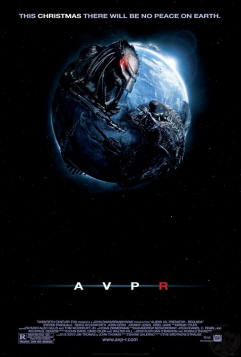
* “
Alien v. Predator: Requiem“: This wasn’t screened for critics, but it’s not so bad. It is what it is–a “B” movie that you expect when you see the title. And it’s not a bad “B” movie. Reyko Aylesworth, from “24,” stars and is the heroine of the movie.
A spaceship run by the Predators and containing the Aliens crashes on earth, and the Aliens escape, chased by the Predators. Meanwhile, the Aliens increase and multiply. Both attack and brutally kill humans and will soon wipe out a region of the United States. Humans in a small town, led by Aylesworth, try to outsmart, kill, and escape the Aliens and Predators.
At least, that’s what I think happens because it’s hard to differentiate between the Aliens and the Predators and I had trouble figuring out which was which (I even got it wrong in this review and, per readers’ corrections, had to reverse my references to the two). The camera doesn’t have any clear, detailed shots of them. The shots are all either blurry, shadows, partial views, and the like. And that seems by design. But it only makes it very confusing. It’s as if the makers of this movie think they are being artsy and sophisticated, but that doesn’t fly in a “B” movie horror flick. The technique fails.
Oh, and by the way, despite everything, the Aliens and Predators are still out there. You knew this inexpensive, lucrative movie franchise would never end. Stay tuned for “AVP: The Next Chapter.”
Best feature: The movie is short, at 1.5 hours. Not for kids. And probably not for anyone who values his/her time. But definitely a light, escapist movie. I can think of plenty of far better such movies that you can rent and watch in the comfort of your own home.
